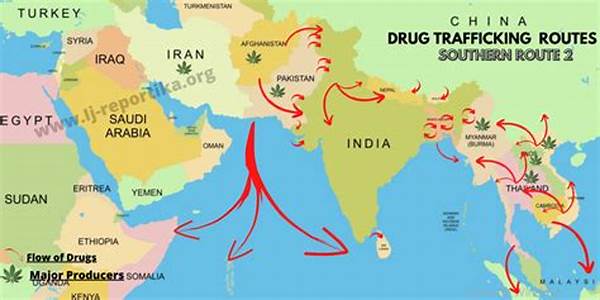In the sphere of international crime, the prevalence of narcotics distribution is a formidable issue that poses significant challenges for global governance and law enforcement. The operations within international drug trafficking networks are complex, encompassing numerous routes, stakeholders, and intricacies that necessitate comprehensive understanding and robust strategies to combat their extensive reach.
The Complex Structure of International Drug Trafficking Networks
International drug trafficking networks are characterized by their intricate and hierarchical structures that allow them to efficiently smuggle and distribute illegal substances across borders. These networks consist of various tiers, including producers, couriers, distributors, and street-level dealers who collaborate to ensure the seamless transition of narcotics from source countries to consumer markets. The multifaceted nature of these organizations enables them to adapt to law enforcement efforts, utilizing techniques such as money laundering and corruption to protect their operations. As a result, tackling these networks requires coordinated international efforts and a deep comprehension of their operational dynamics.
Key Players in International Drug Trafficking Networks
1. Producers: At the foundation of international drug trafficking networks are the producers who cultivate and manufacture illicit substances in regions prone to corruption and weak law enforcement.
2. Transporters: Transporters assume pivotal roles by smuggling drugs across international borders, utilizing a myriad of tactics to evade detection and ensure their contraband reaches the intended markets.
3. Distributors: These individuals or groups function as intermediaries within international drug trafficking networks, facilitating the flow of narcotics from transporters to street-level dealers.
4. Money Launderers: Essential to international drug trafficking networks, money launderers obscure illegal profits to maintain financial stability and shield operations from law enforcement scrutiny.
5. Corrupt Officials: Corruption is rampant in international drug trafficking networks, with officials sometimes cooperating with traffickers in exchange for financial incentives, ultimately impeding justice.
Efforts to Combat International Drug Trafficking Networks
Addressing the pervasive challenge of international drug trafficking networks necessitates comprehensive, cooperative approaches among nations. Law enforcement agencies worldwide leverage shared intelligence, tactics, and resources to dismantle these networks systematically. Multinational agreements and task forces have been established to enhance coordination and strengthen legal frameworks, providing a united front against these illicit activities. Governments worldwide are increasingly adopting collaborative efforts, recognizing that the defeat of these criminal organizations requires unified action and persistent dedication. Despite notable successes, the relentless evolution of international drug trafficking networks demands ongoing vigilance and adaptation.
Challenges in Dismantling International Drug Trafficking Networks
The dismantling of international drug trafficking networks presents an array of significant challenges. Firstly, their highly adaptive nature allows them to restructure and modify operations in response to law enforcement interventions. Secondly, these networks often employ sophisticated technology and communication means, complicating tracking and monitoring efforts by authorities. Lastly, the pervasive influence of corruption within various jurisdictions poses significant hurdles, as complicit officials can obstruct the progress of investigative and prosecutorial actions. Consequently, confronting these challenges requires multifaceted strategies and unwavering international cooperation.
The Socio-Economic Impact of International Drug Trafficking Networks
The repercussions of international drug trafficking networks extend beyond legal and enforcement concerns, affecting public health, socio-economic stability, and security. In regions infiltrated by these networks, communities often suffer from increased crime rates, public health crises, and economic instability. The drugs trafficked by these networks contribute to widespread addiction, adversely impacting workforce productivity and placing additional burdens on healthcare systems. Addressing the socio-economic ramifications necessitates a holistic approach, integrating prevention, education, and rehabilitation initiatives to mitigate the effects of drug trafficking on society.
International Collaboration Against Drug Trafficking Networks
International collaboration represents a cornerstone in the fight against international drug trafficking networks. Various multilateral initiatives and agreements, such as the United Nations Convention against Illicit Traffic in Narcotic Drugs and Psychotropic Substances, aim to forge unified strategies and policies. These partnerships facilitate the exchange of information, expertise, and resources, thereby enhancing the capacity to anticipate, target, and dismantle these networks effectively. Furthermore, strengthening judicial systems and fostering international solidarity are pivotal for ensuring sustained progress in combating this global menace.
Conclusion: Summarizing the Battle Against International Drug Trafficking Networks
In summary, international drug trafficking networks represent a complex and persistent threat to global security and public health. With their sophisticated operations, these networks continue to exploit vulnerabilities within and between nations, demanding robust, coordinated responses. International cooperation and collaboration remain crucial in addressing this multifaceted issue, requiring innovative strategies and unwavering commitment from the global community. As nations work together to dismantle and eradicate these networks, ongoing vigilance and adaptation in policy and enforcement strategies will be essential in prevailing over this substantial global challenge.





